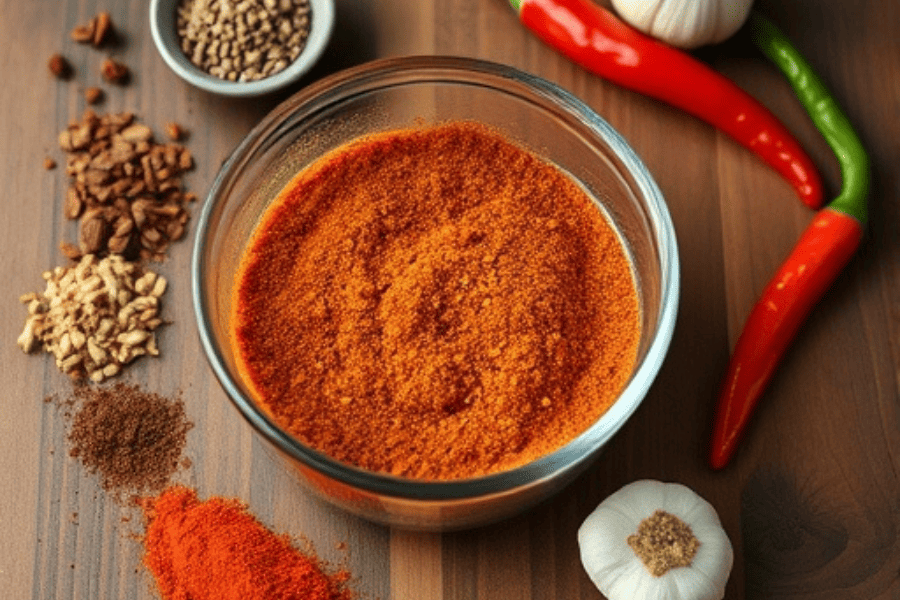Introduction
Chicken fajita seasoning is a flavorful blend of spices and herbs that brings the vibrant and zesty essence of Mexican cuisine to your table. This seasoning mix is essential for crafting the perfect chicken fajitas, adding depth and complexity to the dish with just the right balance of heat, smokiness, and earthy undertones.
Used widely in Tex-Mex and Mexican dishes, chicken fajita seasoning is much more than a spice blend—it’s a versatile ingredient that elevates a variety of recipes. This article will explore its core ingredients, the benefits of making it at home, and creative ways to use it in your cooking.
What Is Chicken Fajita Seasoning?

Chicken fajita seasoning is a mix of spices and herbs used to give chicken fajitas their bold and delicious flavor. Fajitas, a popular dish in Mexican and Tex-Mex cuisine, are made with seasoned meat, sautéed peppers, and onions, all wrapped in a soft tortilla. The seasoning blend is what makes fajitas stand out, adding a smoky, slightly spicy, and savory taste that everyone loves.
This seasoning is versatile and works well not only with chicken but also with beef, shrimp, or even vegetarian dishes. It’s a great way to bring the vibrant flavors of Mexican food to your kitchen with just a sprinkle of the mix.
Core Ingredients in Chicken Fajita Seasoning
The magic of chicken fajita seasoning lies in its simple yet powerful ingredients. Each spice plays an important role in creating the signature taste. Here are the key components:
- Chili Powder: This adds a smoky and slightly spicy base to the seasoning.
- Cumin: Known for its warm, earthy flavor, cumin gives fajitas their traditional Mexican touch.
- Garlic Powder: Adds a savory and aromatic punch.
- Onion Powder: Balances the flavors with its mild sweetness.
These are the foundation of any good fajita seasoning, but the blend doesn’t stop there.
Additional Spices and Herbs
For an even more complex and delicious seasoning mix, these extra ingredients are often added:
- Paprika: Regular paprika adds color, while smoked paprika brings a deep, smoky flavor.
- Oregano: A hint of herbal freshness complements the spice.
- Cayenne Pepper: This is for those who like a little more heat.
Each of these spices enhances the flavor profile, making chicken fajita seasoning a well-rounded blend that’s bursting with taste.
Optional Ingredients for Customization
While the main ingredients form the base of chicken fajita seasoning, you can make it your own by adding a few extras. These optional ingredients let you adjust the flavor to suit your taste:
- Sugar: A tiny bit of sugar can balance the spices, especially if you like a touch of sweetness in your fajitas.
- Coriander: This spice has a citrusy flavor that can make the seasoning feel fresher.
- Crushed Red Pepper Flakes: Perfect for those who enjoy a bit more heat.
- Lime Zest: Adding lime zest can bring a tangy and zesty kick to the blend.
These additions aren’t necessary, but they can take your seasoning to the next level. Don’t be afraid to experiment with small amounts until you find the combination you love.
How to Make Chicken Fajita Seasoning at Home
Making chicken fajita seasoning at home is super easy and takes just a few minutes. Plus, it’s a great way to ensure you’re using fresh ingredients with no added preservatives. Here’s how you can do it:
- Gather the Ingredients: Start with the core spices—chili powder, cumin, garlic powder, and onion powder. If you want, include optional spices like paprika, oregano, cayenne pepper, or sugar.
- Measure the Spices: Use equal amounts of chili powder and cumin (about 2 teaspoons each), followed by 1 teaspoon each of garlic powder and onion powder. Add smaller amounts of the optional ingredients to taste.
- Mix Everything Together: Combine all the spices in a bowl and stir until they’re well blended.
- Store the Seasoning: Transfer the mix to an airtight container or spice jar. Store it in a cool, dry place for up to six months.
Tips for Success:
- If you’re new to making your own seasoning, start small and adjust the spices as you go.
- Want a salt-free blend? Simply leave out the salt and add it separately when cooking.
- Love spicy food? Add a pinch of cayenne pepper or crushed red pepper flakes for extra heat.
With just a little effort, you’ll have a homemade chicken fajita seasoning that’s fresh, flavorful, and free of unnecessary additives.
Store-Bought vs. Homemade Seasoning
When deciding between store-bought and homemade chicken fajita seasoning, it helps to know the pros and cons of each option.
- Store-Bought Seasoning:
Many people choose store-bought seasoning because it’s quick and convenient. These blends are pre-made and ready to use. However, they might contain preservatives, added salt, or artificial flavors that some people prefer to avoid. - Homemade Seasoning:
Making your own seasoning is simple and gives you full control over the ingredients. You can adjust the salt, spice level, and even add special touches like lime zest or smoked paprika. While it takes a little time to prepare, it’s often fresher and more flavorful than store-bought versions.
Which One Is Better?
If you’re in a rush, store-bought seasoning can save time. But if you want a blend that’s healthier and tailored to your taste, homemade is the way to go. Plus, homemade seasoning is usually more cost-effective in the long run.
Common Uses for Chicken Fajita Seasoning
Chicken fajita seasoning isn’t just for fajitas! It’s a versatile spice blend that can add flavor to many dishes. Here are some popular ways to use it:

- Marinating Chicken:
Rub the seasoning onto chicken breasts, thighs, or tenders before grilling, roasting, or pan-frying. Add a little olive oil or lime juice to make the marinade even better. - Seasoning Vegetables:
Toss sliced peppers, onions, zucchini, or mushrooms with the seasoning and roast them in the oven. They make a great side dish or fajita filling. - Enhancing Rice and Soups:
Sprinkle the seasoning into cooked rice or soups for a zesty Mexican-inspired twist. It’s an easy way to add depth to simple recipes. - Making Tacos or Burritos:
Use chicken fajita seasoning to flavor taco or burrito fillings. It pairs perfectly with beans, cheese, and fresh toppings like guacamole. - Spicing Up Snacks:
Try sprinkling the seasoning on popcorn, roasted nuts, or even tortilla chips for a quick and tasty snack.
With so many uses, chicken fajita seasoning is a must-have in your spice cabinet. Once you try it in different dishes, you’ll see how it can transform ordinary meals into something exciting and flavorful.
Variations for Dietary Preferences
One of the best things about chicken fajita seasoning is how easy it is to adapt for different diets. With a few small changes, you can make it suitable for everyone at your table.
- Low-Sodium Option:
If you’re watching your salt intake, simply leave out the salt in your seasoning mix. You can always add a small pinch while cooking if needed. - Gluten-Free Blend:
Most homemade seasoning blends are naturally gluten-free because they’re made with single spices. Just double-check your ingredients to ensure there’s no cross-contamination. - Vegan-Friendly Seasoning:
Chicken fajita seasoning is already vegan! Just be sure to use fresh, plant-based ingredients and avoid any pre-mixed spice packets that might include animal products like powdered cheese or broth. - Mild Blend for Kids:
If you’re cooking for kids or anyone who doesn’t like spicy food, reduce or skip the cayenne pepper and crushed red pepper flakes. The blend will still be flavorful without the extra heat.
These variations make it easy to customize the seasoning for any dietary need. Everyone can enjoy the delicious taste of fajitas!
Tips for Storing Chicken Fajita Seasoning

To keep your seasoning fresh and flavorful, it’s important to store it the right way. Here are some simple tips:
- Use an Airtight Container:
Store the seasoning in a jar with a tight lid to keep out air and moisture. A small mason jar or a resealable spice container works great. - Keep It in a Cool, Dry Place:
Place the container in a pantry or cupboard, away from direct sunlight or heat. Spices can lose their flavor if exposed to light or high temperatures. - Label and Date It:
Write the name and the date you made the seasoning on the container. This way, you’ll know when it’s time to make a fresh batch. - Check for Freshness:
Over time, spices lose their potency. If your seasoning starts to smell faint or doesn’t taste as strong, it’s time to replace it. Usually, homemade blends stay fresh for up to six months.
By following these tips, you can enjoy the vibrant flavors of chicken fajita seasoning every time you use it.
FAQs
- What Is Fajita Marinade Made Of for Chicken?
Fajita marinade is a flavorful liquid blend used to tenderize and season chicken before cooking. It typically includes:- Citrus juice: Lime or lemon juice for a tangy flavor and to help tenderize the meat.
- Oil: Olive oil or vegetable oil to coat the chicken and prevent it from drying out.
- Spices: A mix of fajita seasoning, including chili powder, cumin, garlic powder, and paprika.
- Garlic and Onion: Freshly minced or powdered versions for added depth.
- Sweetener (optional): A touch of honey or sugar to balance the acidity and spices.
Simply mix these ingredients, coat the chicken, and let it marinate for a few hours to soak up the flavors.
- Can You Marinate Fajitas Too Long?
Yes, it’s possible to marinate fajitas for too long. While marinating adds flavor and tenderizes the meat, leaving it in the marinade for too long, especially if it contains citrus juice or vinegar, can break down the chicken’s texture too much. This makes the meat mushy instead of juicy.
Ideal Marination Times:
- For chicken: 2–6 hours is best. Avoid marinating for more than 12 hours.
- For quick marinades: 30 minutes to 1 hour works well if you’re short on time.
- What Is the Formula for Chicken Marinade?
A good chicken marinade typically follows this simple formula:
1 part acid + 2 parts oil + spices and aromatics
- Acid: Citrus juice (like lime or lemon), vinegar, or even yogurt. This helps tenderize the meat and adds flavor.
- Oil: Olive oil, vegetable oil, or avocado oil keeps the chicken moist during cooking.
- Spices and Aromatics: Use a fajita seasoning blend along with garlic, onion, or fresh herbs to create a balanced flavor.
For example:
- 1/4 cup lime juice (acid)
- 1/2 cup olive oil (oil)
- 2 tablespoons fajita seasoning (spices)
Adjust the amounts based on how much chicken you’re marinating, and always taste-test the marinade before using it.
Conclusion
Chicken fajita seasoning and marinades are essential for creating flavorful and juicy fajitas. The seasoning is a simple mix of spices like chili powder, cumin, garlic powder, and paprika, while the marinade combines citrus juice, oil, and seasonings to tenderize and enhance the chicken.
We’ve learned that chicken fajita seasoning is versatile, easy to make at home, and customizable to suit any taste or diet. You can also adjust the spiciness or create low-sodium and gluten-free versions. For marinades, following a basic formula of 1 part acid + 2 parts oil + spices ensures your chicken stays tender and packed with flavor.
Remember not to marinate the chicken for too long—2 to 6 hours is just right. And if you’re in a hurry, a quick 30-minute soak will still make your fajitas delicious.
Whether you use this seasoning for fajitas, roasted vegetables, or snacks, it’s a fantastic way to bring bold, smoky flavors to your meals. Try making it at home, and you’ll never go back to store-bought again!

